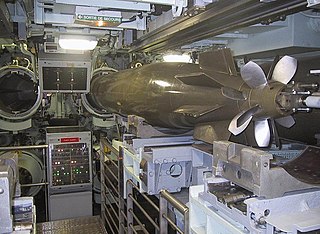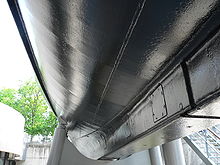
A torpedo tube is a cylindrical device for launching torpedoes.

A dry suit or drysuit provides the wearer with environmental protection by way of thermal insulation and exclusion of water, and is worn by divers, boaters, water sports enthusiasts, and others who work or play in or near cold or contaminated water. A dry suit normally protects the whole body except the head, hands, and possibly the feet. In hazmat configurations, however, all of these are covered as well.

A bathyscaphe is a free-diving, self-propelled deep-sea submersible, consisting of a crew cabin similar to a Bathysphere, but suspended below a float rather than from a surface cable, as in the classic Bathysphere design.

USS S-5 (SS-110) was a "Government-type" S-class submarine of the United States Navy. Her keel was laid down on 4 December 1917 by the Portsmouth Navy Yard of Kittery, Maine. She was launched on 10 November 1919, sponsored by Mrs. Glenn S. Burrell, and commissioned on 6 March 1920 with Lieutenant Commander Charles M. "Savvy" Cooke, Jr., in command. She sank accidentally during full-power trials on 1 September 1920, but due to actions by her crew and the crews of other ships, there were no deaths. Refloated, she was lost when she sank again while under tow on 3 September 1920.

A buoyancy compensator (BC), also called a buoyancy control device (BCD), stabilizer, stabilisor, stab jacket, wing or adjustable buoyancy life jacket (ABLJ), depending on design, is a type of diving equipment which is worn by divers to establish neutral buoyancy underwater and positive buoyancy at the surface, when needed.

A diving helmet is a rigid head enclosure with a breathing gas supply used in underwater diving. They are worn mainly by professional divers engaged in surface-supplied diving, though some models can be used with scuba equipment. The upper part of the helmet, known colloquially as the hat or bonnet, may be sealed directly to the diver using a neck dam, connected to a diving suit by a lower part, known as a breastplate, or corselet, depending on regional language preferences. or simply rest on the diver's shoulders, with an open bottom, for shallow water use.

A submersible is an underwater vehicle which needs to be transported and supported by a larger watercraft or platform. This distinguishes submersibles from submarines, which are self-supporting and capable of prolonged independent operation at sea.

A diving bell is a rigid chamber used to transport divers from the surface to depth and back in open water, usually for the purpose of performing underwater work. The most common types are the open-bottomed wet bell and the closed bell, which can maintain an internal pressure greater than the external ambient. Diving bells are usually suspended by a cable, and lifted and lowered by a winch from a surface support platform. Unlike a submersible, the diving bell is not designed to move under the control of its occupants, or to operate independently of its launch and recovery system.

K-429 was a Project 670-A Скат nuclear submarine of the Soviet Navy. Her keel was laid down on 26 January 1971 at Krasnoye Sormovo in Gorky. She was launched on 22 April 1972, and was commissioned on 31 October 1972 into the Soviet Pacific Fleet.

The K-class submarines were a class of steam-propelled submarines of the Royal Navy designed in 1913. Intended as large, fast vessels with the endurance and speed to operate with the battle fleet, they gained notoriety and the nickname of "Kalamity class" for being involved in many accidents. Of the 18 built, none were lost through enemy action, but six sank, with significant loss of life, in accidents. Only one ever engaged an enemy vessel, K-7 hitting a U-boat amidships, though the torpedo failed to explode with what has been described as typical "K" luck; K-7 escaped retaliation by steaming away at speed.

A ballast tank is a compartment within a boat, ship or other floating structure that holds water, which is used as ballast to provide hydrostatic stability for a vessel, to reduce or control buoyancy, as in a submarine, to correct trim or list, to provide a more even load distribution along the hull to reduce structural hogging or sagging stresses, or to increase draft, as in a semi-submersible vessel or platform, or a SWATH, to improve seakeeping. Using water in a tank provides easier weight adjustment than the stone or iron ballast used in older vessels, and makes it easy for the crew to reduce a vessel's draft when it enters shallower water, by temporarily pumping out ballast. Airships use ballast tanks mainly to control buoyancy and correct trim.

A radio-controlled submarine is a scale model of a submarine that can be steered via radio control. The most common form are those operated by hobbyists. These can range from inexpensive toys to complex projects involving sophisticated electronics. Oceanographers and military units also operate radio-controlled submarines.

The Davis Submerged Escape Apparatus, was an early type of oxygen rebreather invented in 1910 by Sir Robert Davis, head of Siebe Gorman and Co. Ltd., inspired by the earlier Fleuss system, and adopted by the Royal Navy after further development by Davis in 1927. While intended primarily as an emergency escape apparatus for submarine crews, it was soon also used for diving, being a handy shallow water diving apparatus with a thirty-minute endurance, and as an industrial breathing set.

In submarine technology a vent is a valve fitted to the top of a submarine's ballast tanks to let air escape from the top of the ballast tank and be replaced by water entering through the opening(s) called "flood ports" or "floods" at the bottom of the tank. In earlier times, the openings at the bottom of the ballast tank were fitted with valves known as Kingston valves. These valves were eliminated in the U.S. Navy between the World Wars.

Saddle tanks are a type of ballast tank configuration fitted to submarines.

Ictíneo I was a pioneering submarine constructed in Barcelona, Spain in 1858–1859 by engineer Narcís Monturiol.

Xifias was a Greek submarine which served during World War I. It was the third submarine to enter service in the Greek navy, and the second and last vessel of the Delfin class. It was taken over by the French in 1916, and decommissioned in 1920 without seeing action.

Scuba skills are skills required to dive safely using self-contained underwater breathing apparatus, known as a scuba set. Most of these skills are relevant to both open-circuit scuba and rebreather scuba, and many also apply to surface-supplied diving. Some scuba skills, which are critical to divers' safety, may require more practice than standard recreational training provides to achieve reliable competence.

I-33 was an Imperial Japanese Navy B1 type submarine. Completed and commissioned in 1942, she served in World War II, making one war patrol that included the Battle of the Eastern Solomons, before sinking accidentally in September 1942. Refloated and repaired, she sank again in a diving accident during post-repair sea trials in June 1944.
A variable-buoyancy pressure vessel system is a type of rigid buoyancy control device for diving systems that retains a constant volume and varies its density by changing the weight (mass) of the contents, either by moving the ambient fluid into and out of a rigid pressure vessel, or by moving a stored liquid between internal and external variable-volume containers. A pressure vessel is used to withstand the hydrostatic pressure of the underwater environment. A variable-buoyancy pressure vessel can have an internal pressure greater or less than ambient pressure, and the pressure difference can vary from positive to negative within the operational depth range, or remain either positive or negative throughout the pressure range, depending on design choices.





















